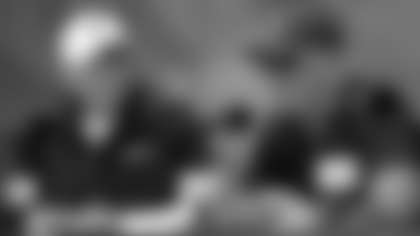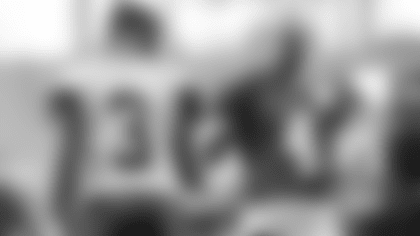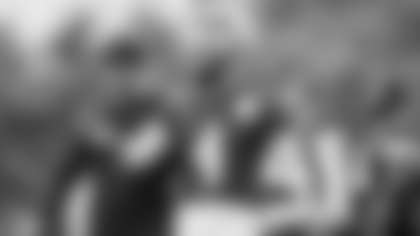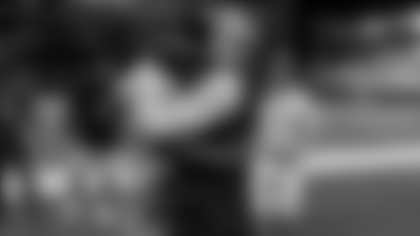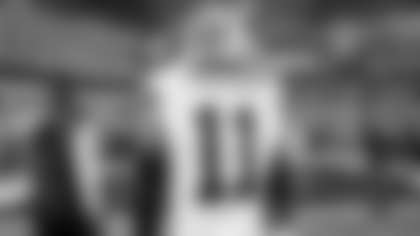FRISCO, Texas – It's a moment that has been discussed breathlessly for months, and on Tuesday the Cowboys confirmed the ending of an era.
Tony Romo has been released by the Dallas Cowboys, concluding a month of speculation about his future with the team. The release comes at Romo's request, as the Pro Bowl quarterback has determined he will retire and pursue a career in broadcasting. Shortly after he was released, CBS announced he will join Jim Nantz and Tracy Wolfson as the network's lead NFL game analyst for the 2017 season.
"We wish Tony and his family nothing but the best," said Cowboys owner/general manager Jerry Jones. "As an organization, we did what he asked us to do in terms of his release, and we wanted to do what was ultimately in his best interest and in the best interest of his family."
The decision effectively ends Romo's 14-year tenure as the face of the Cowboys franchise. Only three players – defensive lineman Ed "Too Tall" Jones, safety Bill Bates and offensive tackle Mark Tuinei – spent more time with the organization.
Starting early Tuesday morning, numerous reports from around the NFL landscape indicated Romo's intention to retire from playing and enter into NFL broadcasting. Regardless of his future plans, the Cowboys still opted to make him a post-June 1 cut from their roster – mainly as a bookkeeping measure.
If Romo had filed his retirement papers while still on the Cowboys' roster, he would have cost the club $19.6 million toward their salary cap in 2017. By releasing him prior to retirement, the Cowboys can split that charge over the next two seasons. He will now cost $10.7 million against the salary cap in 2017 and $8.9 million in 2018.
The June 1 designation will save the Cowboys $14 million this year – though those funds won't become available until June 2.
Romo is set to turn 37 later this month, and the Cowboys' eventual decision to part ways with him comes after a whirlwind season that team owner/general manager Jerry Jones could only describe as "miraculous."
Having missed the majority of the 2015 season with a broken collarbone, Romo returned to the lineup last summer with a highly-touted new running back in Ezekiel Elliott and high expectations for 2016. Fate intervened, however, as he fractured a vertebrae on just the third play of his only preseason appearance – leaving the Cowboys without their No. 1 quarterback for a second-consecutive season.
Romo's injury opened the door for fourth-round draft pick Dak Prescott to step into the starting role, and no one should need a refresher on what the rookie accomplished in his debut season. Under Prescott's guidance, the Cowboys surged to an unexpected 13-3 record, sparked by an 11-game win streak following a loss in the season opener.
The unprecedented run was highlighted by some impromptu theatrics on Nov. 15, when Romo gave an unexpected statement, effectively ceding the Cowboys' starting spot to the younger quarterback.
"He's earned the right to be our quarterback," Romo said of Prescott at the time. "As hard as that is for me to say, he's earned that right."
If nothing else, Romo's release should underscore the Cowboys' commitment to their second-year signal-caller. Prescott earned Pro Bowl honors alongside Elliott in 2016 and was named the NFL's Offensive Rookie of the Year for his efforts.
But the circumstances of Romo's departure don't diminish his accomplishments over the past 14 years – 10 of which he spent as the Cowboys' starter.
The Burlington, Wis., product leaves Dallas with virtually every significant passing record in Cowboys history. His 34,183 career passing yards and 248 career touchdowns are franchise records. His career passer rating of 97.1 is the fourth-best in the history of the NFL.
His single-season passer rating of 113.2, set when he led the Cowboys to a 12-4 record in 2014, is the seventh-best season in league history – and arguably the best campaign of his decorated career.
For perspective's sake, consider that only one man in the rich history of the Dallas Cowboys has started more games at quarterback than Tony Romo – three-time Super Bowl champion and Pro Football Hall of Famer Troy Aikman.
All of that said, Romo's career was about far more than sheer numbers. He captured the NFL's attention by rising from an undrafted free agent to the starting quarterback of the league's most visible franchise, slinging his way to Pro Bowls and playoff appearances in his first two seasons under center.
He also earned a well-deserved reputation for playing a similar style to his childhood hero, Brett Favre – a breathtaking blend of athleticism, on-field adlibs and effortless braggadocio.
Ask for a list of Romo's greatest plays and you're just as likely to see a run -- such as his 30-yard scramble after an errant snap against the Rams – as a pass. That ridiculous escapability would become synonymous with his playstyle, as he spun out of sacks from some of the NFL's best to deliver touchdown strikes over the course of the past decade.
When he wasn't escaping from certain injury, he was playing through it. Given the way his final few seasons in Dallas played out, it's easy to gloss over Romo's ironman dedication to the cause. But it's impossible to forget the Cowboys' 2011 win against San Francisco, when he suffered a cracked rib and a punctured lung on the third play from scrimmage – and returned in time to guide the Cowboys to an overtime victory.
Then there was Week 16 of 2013, when Romo herniated a disc in his back while escaping pressure against the Washington Redskins, yet still managed to lead a game-saving touchdown drive, preserving the Cowboys' playoff hopes in the process.
It's that trademark style that marked Romo's entire career, and it brought about plenty of highs and lows in the process. Romo is currently credited with 25 fourth quarter comebacks – 14th best in NFL history and tied for fifth-best among active quarterbacks.
"Tony Romo has a unique combination of athletic ability, arm talent, vision and instincts for the game," said Cowboys coach Jason Garrett on Tuesday. "What separates Tony from many other players, however, is a rare competitive spirit. Tony loves to play. Tony loves to compete. The best ones always do. In practice. During games. On the field. Off the field. Tony competes to the end in everything that he does."
But just as no Romo highlight package would be complete without his escape from J.J. Watt, so too should it include his mishandled snap on a potential game-winning field goal in a 2007 wildcard playoff loss to Seattle.
Cruel as it may be to admit, Romo's stint as the Cowboys' starter will be marked by coming oh-so-close, so many times. Whether it was the divisional round exit to the New York Giants after a 13-3 campaign, three-straight losses in do-or-die Week 17 games or the gut-wrenching divisional round loss to Green Bay in January 2015, the list of heartaches is a long one.
The classic adage says that quarterbacks receive too much of the credit when things go well and too much of the blame when they don't – and never has that been proven more correct than in the case of Tony Romo.[embeddedad0]
It's something that isn't lost on the Cowboys' front office, and the franchise's lack of hardware during Romo's tenure is something Jerry Jones has repeatedly called one of his biggest regrets.
Cowboys executive vice president Stephen Jones reiterated that point as recently as February, at the NFL Combine, when he reflected on Romo's career.
"I think Jerry said it best. Unfortunately that's one of our biggest regrets, that we haven't been able to put a team around Tony when he's healthy that he could win a Super Bowl," he said. "Because I certainly think he's very capable of it."
That refrain of "what if" didn't get any easier in the final stretch of Romo's Cowboys career. Fresh off an NFC East title in 2014, he fractured the collarbone on Sept. 20, 2015 – effectively sinking a promising season before it could start.
The ensuing 4-12 record put the Cowboys in position to draft Elliott, setting the stage for a comeback tour in 2016. But that narrative went awry after just three snaps on a cool evening in Seattle, forging the path that has led to now.
Romo's release frees up the Cowboys to move forward in a new direction with a new quarterback for the first time since 2006. But even now, it'd be impossible to deny the impact Romo has had.
It's evidently clear that he moves on as one of the most decorated players in a storied franchise's history, as well as the face that an entire generation of fans associates with the Dallas Cowboys.
As for the quarterback himself, all signs point toward Romo starting a new phase of his career. He reportedly fielded calls from several television networks before ultimately deciding to sign on with CBS.
It is important to note, however, that the Cowboys' decision to release Romo does leave the door open for the possibility of a return to football. Had Romo retired as a member of the Cowboys, the team would have still held the rights to his contract – keeping him under club control.
Instead, he enters into retirement as a free agent, making him available to any NFL team that might call in the coming weeks or months.
It's hard to predict definitively what the future holds for Tony Romo. But in circling back to his emotional words from November 2016, it's not a stretch to think his career isn't quite finished.
"If you think for a second that I don't want to be out there, then you've probably never felt the pure ecstasy of competing and winning," he said at the time. "That hasn't left me. In fact it may burn more now than ever."





